Highly Efficient Solar Steam Generation by W18O49@PVA Gels
Abstract
1. Introduction
2. Results and Discussion
3. Conclusions
4. Materials and Methods
4.1. Materials
4.2. Procedures of the Composite Gel Synthesis
4.2.1. The Synthesis of Tungsten Oxide
4.2.2. Preparation of PVA Gel
4.2.3. Preparation of W18O49@PVA Composite Gel
4.2.4. Experiment of Solar Steam Generation
4.3. Characterization
Author Contributions
Funding
Institutional Review Board Statement
Informed Consent Statement
Data Availability Statement
Acknowledgments
Conflicts of Interest
References
- Abdullah, H.; Shuwanto, H.; Astarini, N.A.; Lie, J.; Ginting, R.T.; Tsai, M.-L.; Shih, S.-J.; Sillanpää, M. A Brief Review of Emerging Strategies in Designing Interfacial Solar Steam Generation for Desalination, Water Purification, Power Generation, and Sea Farming. ACS Appl. Energy Mater. 2025, 8, 2663–2704. [Google Scholar] [CrossRef]
- Zhang, Z.; Xu, Y.; Ma, T.; Sèbe, G.; Niu, Y.; Wang, Y.; Tang, B.; Zhou, G. Bio-based interfacial solar Steam generator. Renew. Sustain. Energy Rev. 2024, 203, 114787. [Google Scholar] [CrossRef]
- Ibrahim, I.; Seo, D.H.; McDonagh, A.M.; Shon, H.K.; Tijing, L. Semiconductor photothermal materials enabling efficient solar steam generation toward desalination and wastewater treatment. Desalination 2021, 500, 114853. [Google Scholar] [CrossRef]
- Wang, Y.; Chen, G.; Chakera, M.; Ma, D. Plasmonic Photothermal Nanomaterials for Solar Steam Generation. Chem. Sci. 2025; accepted. [Google Scholar] [CrossRef]
- Zhu, J.; Huang, L.; Bao, F.; Chen, G.; Song, K.; Wang, Z.; Xia, H.; Gao, J.; Song, Y.; Zhu, C.; et al. Carbon materials for enhanced photothermal conversion: Preparation and applications on steam generation. Mater. Rep. Energy 2024, 4, 100245. [Google Scholar] [CrossRef]
- Hou, J.; Zhu, Y.; Zhao, H.; Wan, Y.; Xu, H.; Li, Y.; Guo, J.; Wang, K.; Yang, Z. Review on the structural design of solar-driven interfacial evaporation. J. Environ. Chem. Eng. 2025, 13, 116462. [Google Scholar] [CrossRef]
- Vemuri, R.S.; Engelhard, M.H.; Ramana, C.V. Correlation between surface chemistry, density, and band gap in nanocrystalline WO3 thin films. ACS Appl. Mater. Interfaces 2012, 4, 1371–1377. [Google Scholar] [CrossRef] [PubMed]
- Tang, Y.; Lai, Y.; Gao, R.; Chen, Y.; Xiong, K.; Ye, J.; Zheng, Q.; Fang, Z.; Pang, G.; Lee, H.-J. Functional Aerogels Composed of Regenerated Cellulose and Tungsten Oxide for UV Detection and Seawater Desalination. Gels 2023, 9, 10. [Google Scholar] [CrossRef]
- Sun, X.; Wu, W.; Liu, N.; Li, P.; Zhao, X.; Qu, Z.; Zhao, K.; Wang, B.; Rong, X.; Zhang, X.; et al. Controlled assembly and synthesis of oxygen-deficient W18O49 films based on solvent molecular strategy for electrochromic energy storage smart windows. Chem. Eng. J. 2024, 499, 156109. [Google Scholar]
- Xiong, Y.; Wu, B.; Lin, Y.; Zhang, M.; Chen, J. Facile synthesis of hierarchical W18O49 microspheres by solvothermal method and their optical absorption properties. Discov. Nano 2024, 19, 89. [Google Scholar] [PubMed]
- Yan, N.-F.; Cui, H.-M.; Shi, J.-S.; You, S.-Y.; Liu, S. Recent progress of W18O49 nanowires for energy conversion and storage. Tungsten 2023, 5, 371–390. [Google Scholar] [CrossRef]
- Qiu, Y.; Wang, Y. Controllable synthesis of W18O49 nanoneedles for high-performance NO2 gas sensors. J. Alloys Compd. 2023, 944, 169199. [Google Scholar] [CrossRef]
- Li, Y.; Bando, Y.; Golberg, D. Quasi-Aligned Single-Crystalline W18O49 Nanotubes and Nanowires. Adv. Mater. 2003, 15, 1294–1296. [Google Scholar] [CrossRef]
- Chen, H.; Cai, W.; Gao, X.; Luo, J.; Su, X. PABA-assisted hydrothermal fabrication of W18O49 nanowire networks and its transition to WO3 for photocatalytic degradation of methylene blue. Adv. Powder Technol. 2018, 29, 1272–1279. [Google Scholar] [CrossRef]
- Gao, X.; Xiao, F.; Yang, C.; Wang, J.; Su, X. Hydrothermal fabrication of W18O49 nanowire networks with superior performance for water treatment. J. Mater. Chem. A 2013, 1, 5831. [Google Scholar] [CrossRef]
- Zhou, G.; Fang, Z.; Li, L.; Wu, S.; Wu, G.; Wang, R. Oxygen-Sensitive Nanomaterials Synthesized in an Open System: Water-Triggered Nucleation and Its Controllability in the Growth Process. Inorg. Chem. 2025, 64, 6811–6815. [Google Scholar] [CrossRef] [PubMed]
- Nayak, A.K.; Pradhan, D. Microwave-Assisted Greener Synthesis of Defect-Rich Tungsten Oxide Nanowires with Enhanced Photocatalytic and Photoelectrochemical Performance. J. Phys. Chem. C 2018, 122, 3183–3193. [Google Scholar] [CrossRef]
- Shen, G.; Bando, Y.; Golberg, D.; Zhou, C. Electron-Beam-Induced Synthesis and Characterization of W18O49 Nanowires. J. Phys. Chem. C 2008, 112, 5856–5859. [Google Scholar] [CrossRef]
- Li, J.; Yan, L.; Li, X.; Song, W.; Li, Y. Porous polyvinyl alcohol/biochar hydrogel induced high yield solar steam generation and sustainable desalination. J. Environ. Chem. Eng. 2022, 10, 107690. [Google Scholar] [CrossRef]
- Li, N.; Zhang, X.; Zhu, J.; Xiong, S.; Xu, Y.; Li, Y. Bioinspired Flexible Composite Hydrogels for Efficient Solar Steam Generation and Stable Electricity Harvest. Nano Lett. 2025, 25, 10072–10081. [Google Scholar] [CrossRef]
- Shi, Y.; Ilic, O.; Atwater, H.A.; Greer, J.R. All-day fresh water harvesting by microstructured hydrogel membranes. Nat. Commun. 2021, 12, 2797. [Google Scholar] [CrossRef] [PubMed]
- Tian, Y.; Wang, X.; Gu, Y.; Mu, X.; Wang, P.; Wei, A.; Zhang, J.; Chen, Y.; Sun, Z.; Jia, L.; et al. Versatile PVA/CS/CuO aerogel with superior hydrophilic and mechanical properties towards efficient solar steam generation. Nano Select 2021, 2, 2380–2389. [Google Scholar] [CrossRef]
- Xu, X.; Zhao, Q.; Liu, Q.; Qiu, J.; Li, J.; Zheng, W.; Cao, J.; Wang, L.; Wang, W.; Yuan, S.; et al. Full-spectrum-responsive Ti4O7-PVA nanocomposite hydrogel with ultrahigh evaporation rate for efficient solar steam generation. Desalination 2024, 577, 117400. [Google Scholar] [CrossRef]
- Zhao, F.; Zhou, X.; Shi, Y.; Qian, X.; Alexander, M.; Zhao, X.; Mendez, S.; Yang, R.; Qu, L.; Yu, G. Highly efficient solar vapour generation via hierarchically nanostructured gels. Nat. Nanotechnol. 2018, 13, 489–495. [Google Scholar] [CrossRef] [PubMed]
- Meera, B.; Vidhya, C.; Nair, R.B.; Surya, R.; Kurian, S. Sustainable sponge-like composite hydrogel evaporator for highly efficient solar steam generation. Mater. Today Sustain. 2023, 23, 100439. [Google Scholar] [CrossRef]
- Pan, W.; Zhao, W.; Li, D.; Liu, M.; Zhang, G.; Xi, X.; Jiang, L. 3D PVA/CNFs/MXene aerogel-based evaporator with anti-biofouling and salt-resistant for efficient solar steam generation and wastewater purification. Desalination 2025, 613, 119038. [Google Scholar] [CrossRef]
- Wang, Y.-H.; Hsu, C.-C.; Hong, S.-H.; Ding, J.-F.; Jeng, U.S.; Kang, D.-Y.; Luo, S.-C.; Tung, S.-H.; Liu, C.-L. A Dual-Function Poly(vinyl alcohol) Hydrogel for Solar Water Production and Thermoelectric Energy Generation. ACS Sustain. Chem. Eng. 2025, 13, 4231–4241. [Google Scholar] [CrossRef]
- Zhang, X.; Sun, L.; Wang, X.; Zou, S.; Cao, C.; Hou, J.; Guo, F.; Li, C.; Shi, W. Hydrogel-based 3D evaporator with cross-linked fixation by carbon dots for ultra-high and stable solar steam generation. Chem. Eng. J. 2024, 497, 154793. [Google Scholar]
- Zhu, M.; Liu, X.; Tian, Y.; Caratenuto, A.; Chen, F.; Zheng, Y. Dome-arrayed chitosan/PVA hydrogel-based solar evaporator for steam generation. Sci. Rep. 2022, 12, 4403. [Google Scholar] [CrossRef] [PubMed]
- Zhang, J.; Zhang, H.; Liu, L.; Li, F.; Wang, S. W18O49 nanorods: Controlled preparation, structural refinement, and electric conductivity. Chem. Phys. Lett. 2018, 706, 243–246. [Google Scholar] [CrossRef]
- Zhang, X.; Yoko, A.; Zhou, Y.; Jee, W.; Mayoral, A.; Liu, T.; Guan, J.; Lu, Y.; Keal, T.W.; Buckeridge, J.; et al. Surface-Driven Electron Localization and Defect Heterogeneity in Ceria. J. Am. Chem. Soc. 2025, 147, 33888–33902. [Google Scholar] [CrossRef] [PubMed]
- Fang, Z.; Jiao, S.; Kang, Y.; Pang, G.; Feng, S. Photothermal Conversion of W18O49 with a Tunable Oxidation State. ChemistryOpen 2017, 6, 261–265. [Google Scholar] [CrossRef] [PubMed]
- Parikh, D.; Yadav, H.; Kapatel, S. Machine learning-based prediction of optical band gap in WO3 and its derivatives for semiconducting applications. Optik 2023, 291, 171310. [Google Scholar] [CrossRef]
- He, M.; DBoukhvalov, W.; Li, H.; Gao, X.; Humphrey, M.G.; Zhang, C.; Huang, Z. Remarkable enhancement of the nonlinear optical absorption of W18O49 by Cu doping. Mater. Today Phys. 2024, 42, 101357. [Google Scholar] [CrossRef]
- Fang, Z.; Jiao, S.; Wang, B.; Yin, W.; Pang, G. A Flexible, Self-Floating Composite for Efficient Water Evaporation. Glob. Chall. 2019, 3, 1800085. [Google Scholar] [CrossRef]
- Gao, M.-h.; Xie, X.; Huang, T.; Zhang, N.; Wang, Y. Glutaraldehyde-assisted crosslinking in regenerated cellulose films toward high dielectric and mechanical properties. Cellulose 2022, 29, 8177–8194. [Google Scholar] [CrossRef]
- Jeon, J.G.; Kim, H.C.; Palem, R.R.; Kim, J.; Kang, T.J. Cross-linking of cellulose nanofiber films with glutaraldehyde for improved mechanical properties. Mater. Lett. 2019, 250, 99–102. [Google Scholar] [CrossRef]
- Zhang, F.; Gao, M.-H.; Wu, C.-Q.; Yang, J.-H.; Zhang, N.; Wang, Y. Glutaraldehyde-assisted crosslinking for the preparation of low dielectric loss and high energy density cellulose composites filled with poly(dopamine) modified MXene. Eur. Polym. J. 2024, 221, 113526. [Google Scholar] [CrossRef]
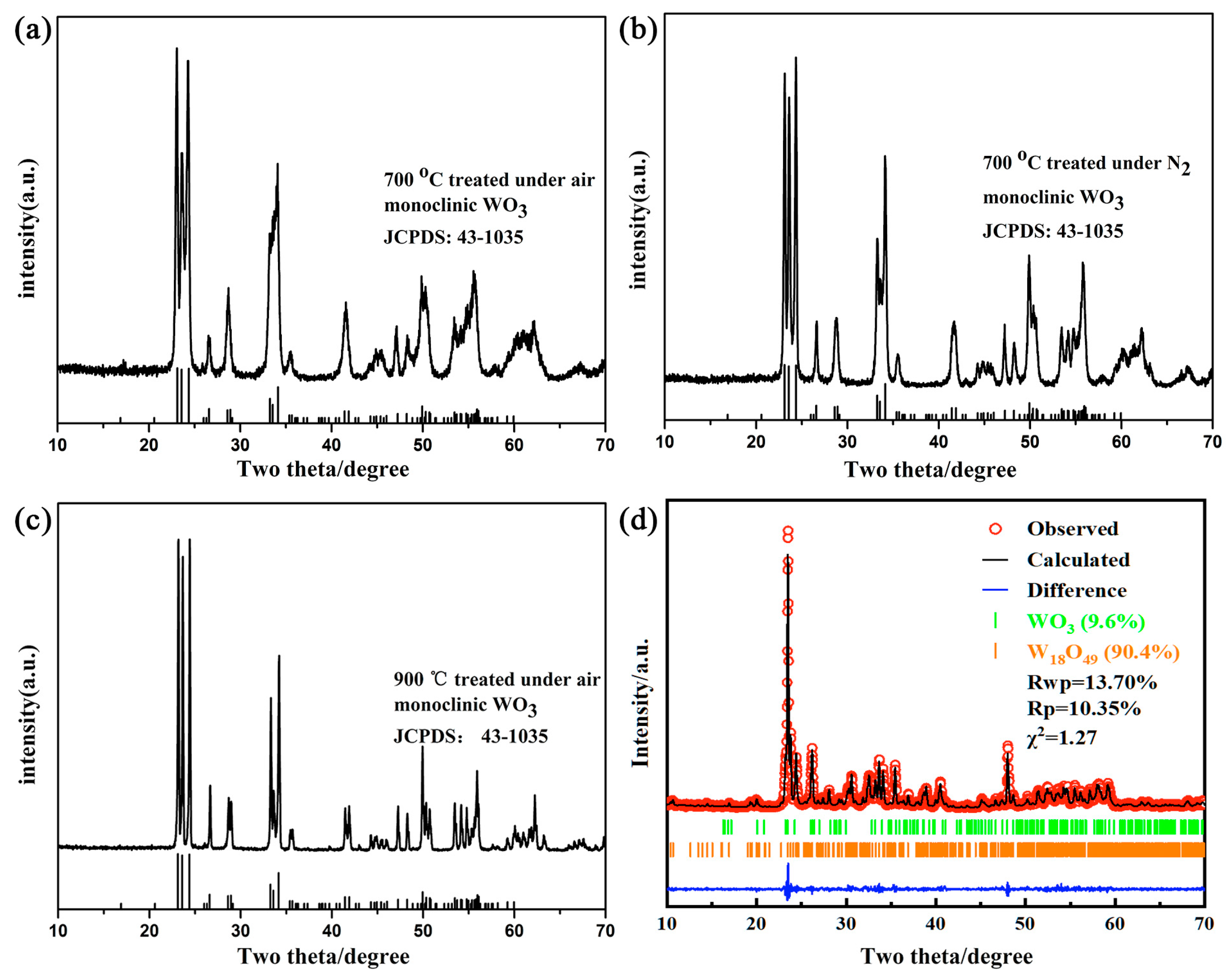

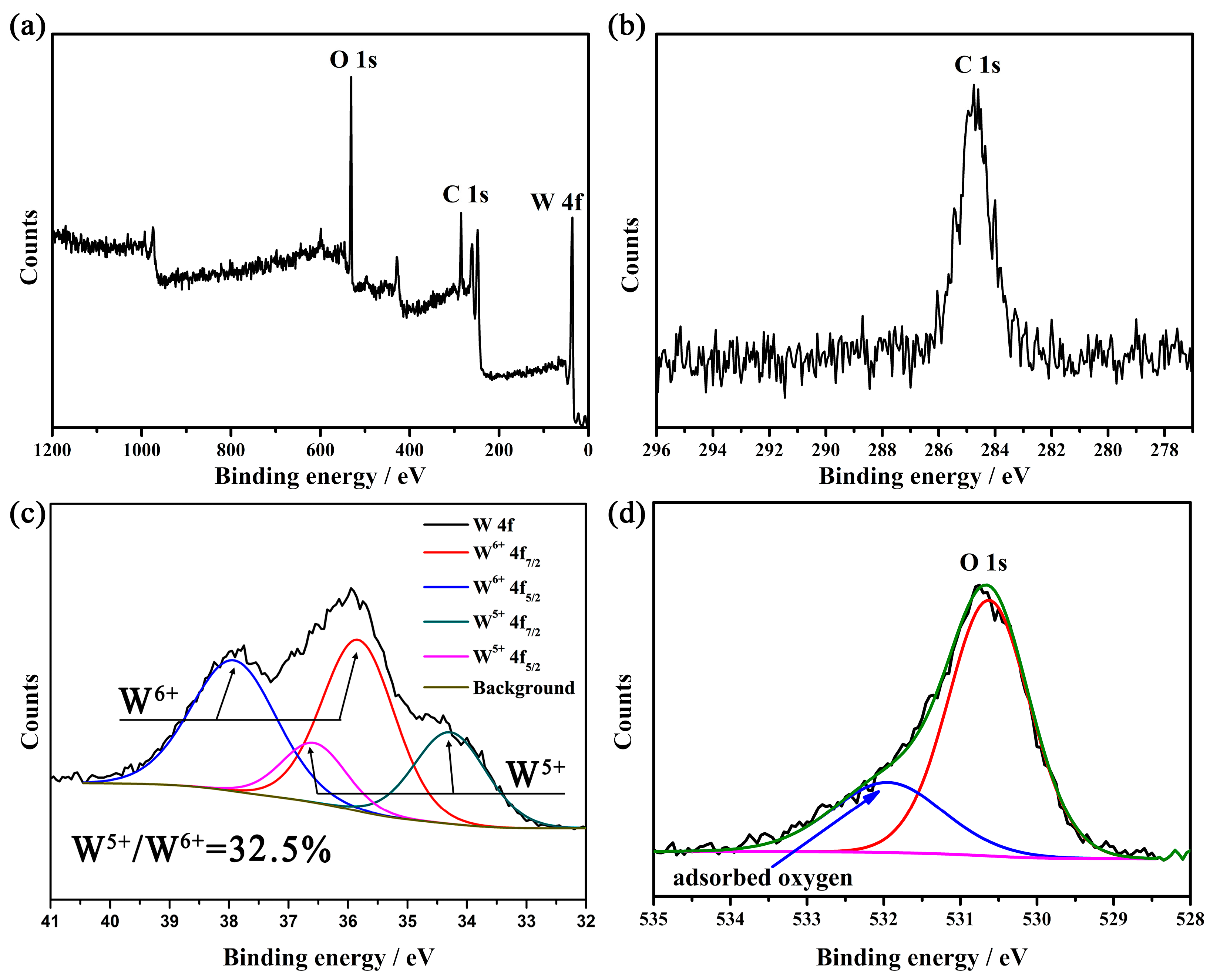
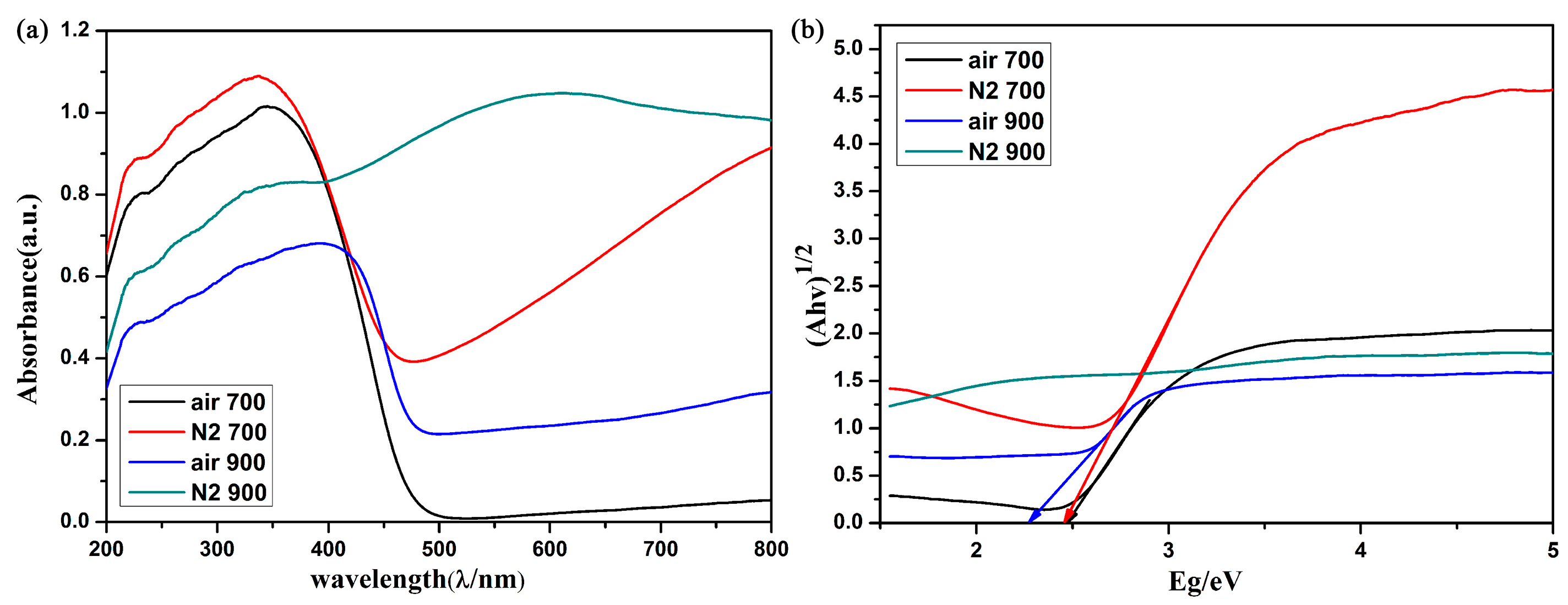
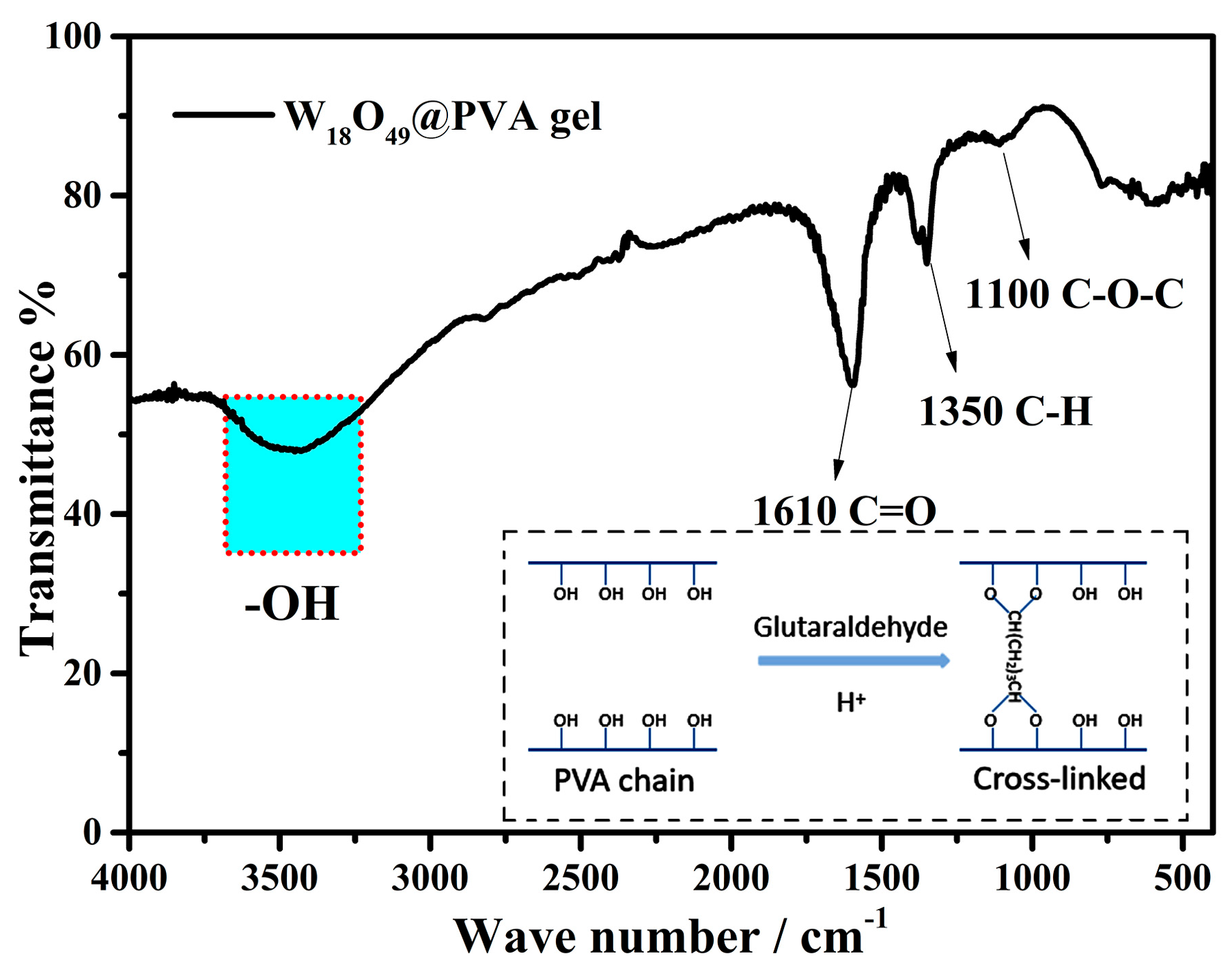

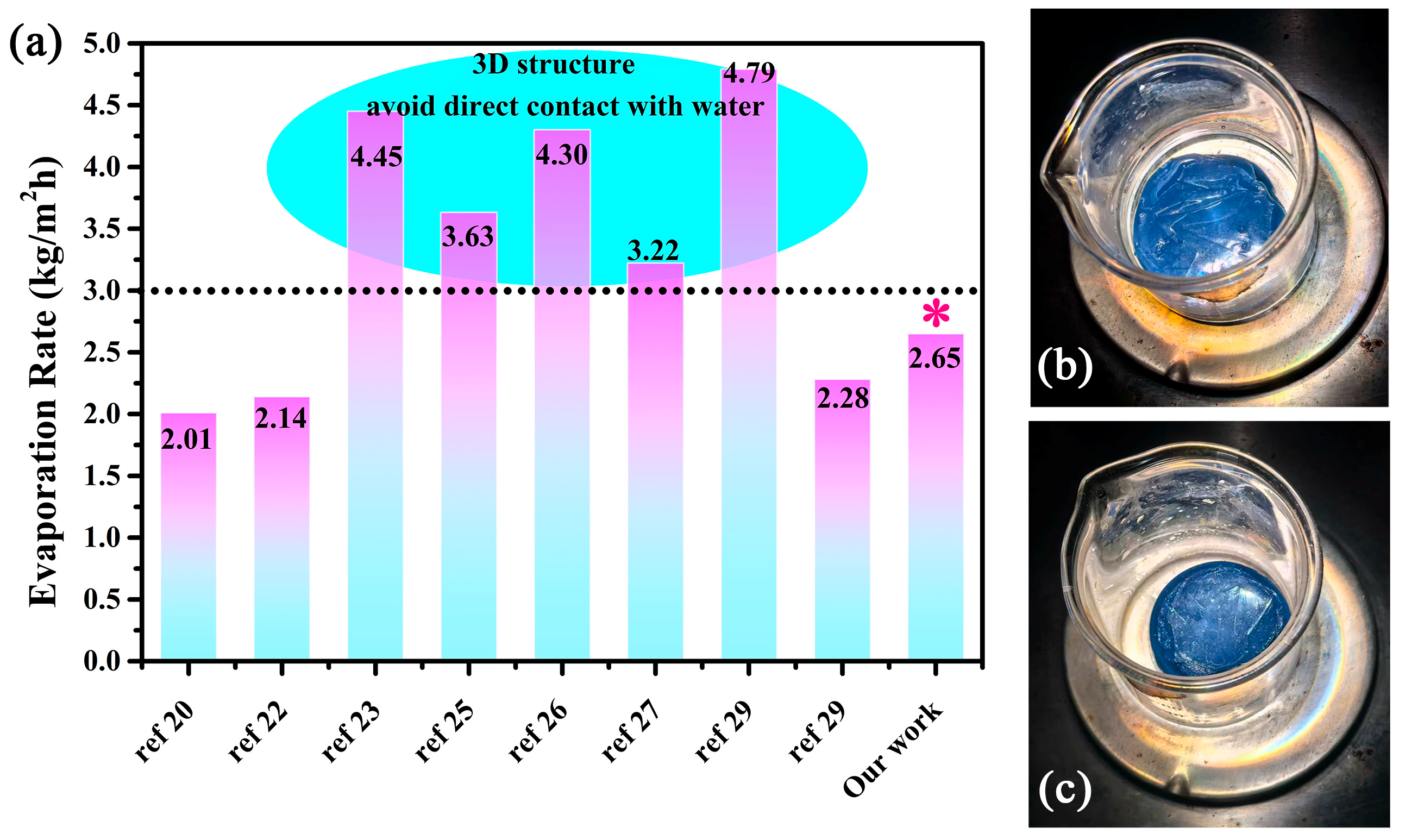
Disclaimer/Publisher’s Note: The statements, opinions and data contained in all publications are solely those of the individual author(s) and contributor(s) and not of MDPI and/or the editor(s). MDPI and/or the editor(s) disclaim responsibility for any injury to people or property resulting from any ideas, methods, instructions or products referred to in the content. |
© 2025 by the authors. Licensee MDPI, Basel, Switzerland. This article is an open access article distributed under the terms and conditions of the Creative Commons Attribution (CC BY) license (https://creativecommons.org/licenses/by/4.0/).
Share and Cite
Yan, J.; Fang, Z.; Hu, J.; Sun, Y.; Huang, X.; Zhou, G.; Li, L.; Wang, R.; Chen, Y. Highly Efficient Solar Steam Generation by W18O49@PVA Gels. Gels 2025, 11, 783. https://doi.org/10.3390/gels11100783
Yan J, Fang Z, Hu J, Sun Y, Huang X, Zhou G, Li L, Wang R, Chen Y. Highly Efficient Solar Steam Generation by W18O49@PVA Gels. Gels. 2025; 11(10):783. https://doi.org/10.3390/gels11100783
Chicago/Turabian StyleYan, Jiefeng, Zhenxing Fang, Jinxing Hu, Yangming Sun, Xinyi Huang, Guannan Zhou, Lu Li, Rui Wang, and Yan Chen. 2025. "Highly Efficient Solar Steam Generation by W18O49@PVA Gels" Gels 11, no. 10: 783. https://doi.org/10.3390/gels11100783
APA StyleYan, J., Fang, Z., Hu, J., Sun, Y., Huang, X., Zhou, G., Li, L., Wang, R., & Chen, Y. (2025). Highly Efficient Solar Steam Generation by W18O49@PVA Gels. Gels, 11(10), 783. https://doi.org/10.3390/gels11100783






